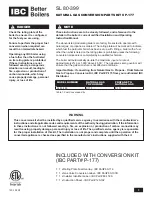
Page 53
7.3 Combi Domestic Hot Water
7.3.1 Mains Water Pressure
To protect the appliance and to prevent excessive flow rates, a pressure reducing
valve
must
be fitted to limit the maximum supply pressure to 3 bar. We strongly
advise that all installation pipework is run in copper. However, if plastic pipe is used,
it must be recommended by the pipe manufacturer for use with oil fired appliances
and, in any case, the last 000mm of pipework connected directly to the appliance
must be of copper. Whenever a pressure reducing valve or other device containing
a non-return valve is fitted to the mains water supply entering the boiler, a mini
expansion vessel must be fitted AFTER the device in order to protect the appliance
from the expansion due to heating of the water in the domestic hot water pipework.
Note that the flow rate from individual taps is dependant on the number of outlets
being operated together, as well as the length and size of pipework and the mains
supply pressure.
7.3.2 Water Hardness
Although many of the DHW components are designed to resist lime scale formation,
in areas of hard water it may still be necessary to fit an inline chemical water softener.
For further information contact Warmflow and your local water company.
7.3.3 Hot Water Pipework
To ensure economic use, the pipe runs between the boiler and the taps should be
as short as possible and insulated to reduce heat loss. Very long pipe runs can lead
to excessive water usage and poor efficiency.
7.3.4 Flow Restrictor
An 8L/min flow restrictor has
been factory fitted but can be
easily removed if required.
7.3.5 Boreholes
Where the mains water supply to the boiler is fed from a borehole via a pump and
accumulator arrangement the variable pressure can cause the mixer valve to go to
its fail safe settings thus preventing the outlet water temperature from achieving a
suitable level. In order to minimise the pressure variations it is recommended that
differential on the borehole pump pressure switch is kept as low as possible without
adversely affecting the pump motor. The accumulator must be as large as possible
in order to reduce the rate of pressure change and a pressure reducing valve (PRV)
must be situated between the pump and accumulator and the boiler. The PRV must
be set slightly below the minimum setting of the pressure switch on the pump.
FLOW SWITCH
FLOW RESTRICTOR
WASHER
Summary of Contents for B-Series B70
Page 1: ......
Page 2: ......
Page 72: ...Page 70 Notes...
Page 73: ...Page 71 Notes...
Page 74: ...Page 72 Notes...
Page 75: ......
Page 76: ......
















































